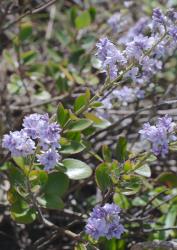- ≡ Hebe hulkeana (F.Muell.) Cockayne & Allan, Trans. New Zealand Inst. 57: 43 (1926)
- ≡ Heliohebe hulkeana (F.Muell.) Garn.-Jones, New Zealand J. Bot. 31: 328 (1993)
- ≡ Parahebe hulkeana (F.Muell.) Heads, Bot. J. Linn. Soc. 115: 82 (1994)
Shrub to 0.7 m tall. Stems decumbent to ascending, glabrous or puberulent; hairs uniform. Leaf bud indistinct; leaves separating while very small, opposite-decussate, erecto-patent to spreading; lamina coriaceous, lanceolate, ovate, or elliptic, 10–60 mm long, 5–35 mm wide, glossy green or dark green above, dull pale green to white or pinkish beneath; midrib evident, secondary veins weakly evident above; surfaces glabrous or with eglandular hairs along midrib above; margin glabrous or rarely ciliolate towards apex, bluntly to sharply serrate; teeth or lobes in 5–20 pairs; apex obtuse to acute; base cuneate to truncate; petiole 5–25 mm long. Inflorescence a terminal compound raceme, 90–480 mm long; flowers crowded, 50–1500, all bisexual; bracts opposite below, becoming alternate above, ovate to deltoid, > pedicels; pedicels spreading, 0–1 mm long, glabrous or glandular- to eglandular-puberulent all around. Calyx lobes 4, obtuse to acuminate, equal, 1.5–3.0 mm long, glandular- to eglandular-ciliate. Corolla 6–10 mm diameter; tube purplish, rarely white, 1.0–1.5 mm long, < calyx, glabrous; lobes 4, pale purplish, rarely white, unequal, spreading, ovate to obovate, 3–5 mm long, obtuse; nectar guides absent. Stamen filaments white or pale purplish, 1.0–1.5 mm long; anthers yellow. Style glabrous or eglandular-hairy, 3.0–4.5 mm long. Capsules turgid, obtuse to emarginate, usually glabrous, sometimes eglandular-hairy, rarely glandular-hairy, 2.5–4.5 mm long, 2–3 mm at widest point. Seeds fusiform to irregular, weakly flattened, winged, smooth, or wrinkled on back, pale to dark brown, 1.0–2.4 mm long.
| 1 | Young stems and petioles puberulent; smaller inflorescence branches densely puberulent or glandular-puberulent; calyx lobes usually obtuse, rarely sub-acute, closely eglandular-ciliate | subsp. hulkeana |
| Stems and petioles glabrous; inflorescence branches either glabrous or sparsely eglandular- or glandular-puberulent; calyx lobes acuminate or acute, distantly glandular-ciliolate or with mixed glandular and eglandular cilia | subsp. evestita |
V. hulkeana belongs to the distinctive sun hebe group, which is characterised by toothed or crenate leaves, terminal paniculate inflorescences, style very much > stamens, ciliate nectarial disc, and fusiform seeds. Among that informal grouping, plants of V. hulkeana can be distinguished by their large leaves with glossy adaxial surfaces and their very large and many-flowered panicles. V. lavaudiana plants have quite large leaves, but these are dull, and their inflorescences have glandular hairs.
Unidentified plants collected from the Omaka River and Black Birch Creek, Marlborough (e.g., CHR 470178) resemble V. pentasepala in their erect habit and narrow leaves, but are more like V. hulkeana in their pale lilac flowers and four free calyx lobes, and like V. scrupea in their four free calyx lobes and narrow leaves that are sometimes acute.
South Island: Marlborough (in the east from near Taylor Pass southwards), Canterbury (in the east from Mt Grey northwards).
Rock outcrops, cliffs, gorges, and sometimes in alluvial gravel. Recorded elevations range from 5 to 1281 m.
| Category | Number |
|---|---|
| Indigenous (Endemic) | 2 |
| Total | 2 |
2n = 42 (Hair 1967, as Hebe hulkeana). The voucher for this record is identified as subsp. hulkeana.
Veronica hulkeana is classified in V. subg. Pseudoveronica sect. Hebe and informally in the “sun hebe” group (Albach & Meudt 2010).




